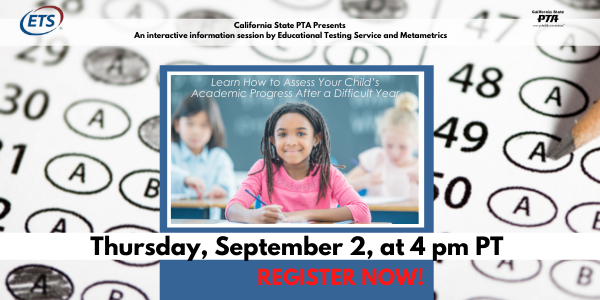by California State PTA Education Commission
Earlier this week, the California Department of Education (CDE) released the results of the California Assessment of Student Performance and Progress (CAASPP) tests administered during the 2021-22 school year.
Smarter Balanced assessments are administered in grades 3-8 and 11, with tests for English language arts/literacy (ELA) and mathematics. In addition, the California Science Test (CAST) assesses students on their mastery of the Next Generation Science Standards in grades five and eight, and once again in high school.
2021-22 School Year Results
This is the first year of CAASPP testing results since 2019, as the State Board of Education suspended mandatory testing during the COVID-19 pandemic. In this data release, student results are reported in four tiers related to mastery of ELA, Math, and Science standards: not met, nearly met, met, or exceeded.
As expected, assessment results revealed the academic impacts of pandemic-era disruptions, underscoring the need for ongoing accelerated learning and support.
Statewide, the percentage of students meeting or exceeding standards on the 2022 Smarter Balanced summative assessments declined by 4 percentage points (from 51 percent to 47 percent) for English language arts (ELA) and 7 percentage points (from 40 percent to 33 percent) for mathematics when compared to students who took the tests in 2018–19—before the pandemic.
State Superintendent of Public Instruction Tony Thurmond shared in the press release, “these baseline data underscore what many of us know: that the road to recovery is long and our students will need sustained support over many years.”
How to Get Engaged
State tests are an objective way of showing how well students met the expectations of their grade level. But, they are only one of many measures and aren’t meant to tell the whole story of a student’s performance.
Here are a few ways you can learn more about the CAASPP results in your area and what they mean for your local schools.
- Look up the results from your child’s school, district and county at the California Department of Education CAASPP webpage.
- Talk with your child’s teacher and ask questions such as:
- “Where does my child need more support or improvement?”
- “What short-term goals should my child meet to show progress?”
- “How can I support learning at home?”
- Talk with district educational leaders and ask questions such as:
- “What strategies does the district have in place to address accelerated learning?”
- “What is the plan for expanded learning funds from the state budget?”
- “How can our district better support strategies to address academic, behavioral and social-emotional needs for all students?”
Download the Family Guide to Annual State Tests in California from National PTA.
